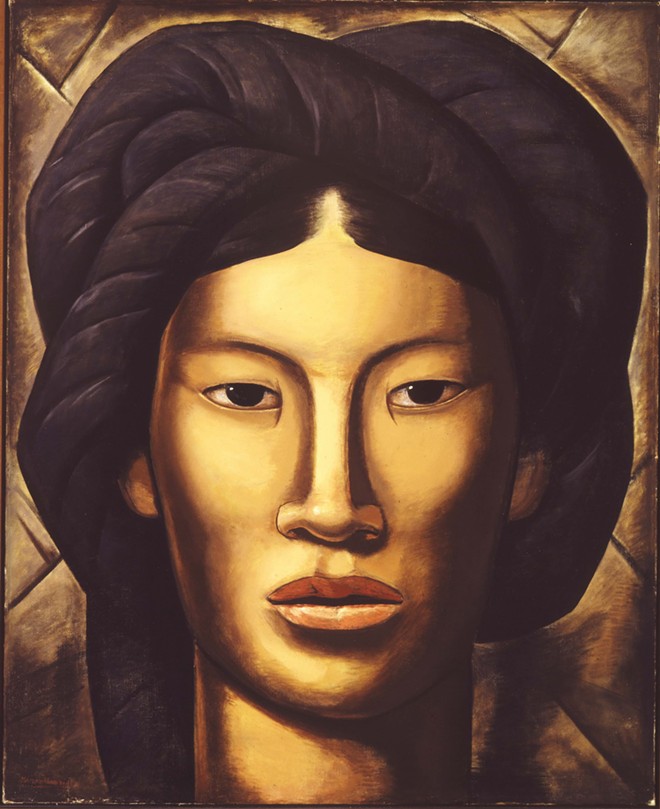
The traveling exhibition "Traitor, Survivor, Icon: The Legacy of La Malinche" commemorates 500 years since the fall of Tenochtitlan, once the capital of the Aztec empire, and examines the complex legacy of a historical figure often called the "Mother of Mexico."
Organized by the Denver Art Museum (DAM), the exhibition is currently on view at the San Antonio Museum of Art and runs through Jan. 8. It's co-curated by Terezita Romo and Victoria I. Lyall, the Jan and Frederick Mayer Curator of Art of the Ancient Americas at the DAM.
The Malinche of the exhibit's title was an enslaved indigenous girl who served as interpreter and translator for Hernán Cortés. She later became his mistress. Also known by the names Malinalli, Malintzin, and Doña Marina, she is the mother of Cortés' first-born son, which placed her in the unique position as a symbol of a modern Mexico built upon both Spanish and indigenous heritage.
While Malinche is the subject of many historical publications, little information is known about her life. As a result, her story has become the subject of great controversy and folklore.
"La Malinche and her story have permeated Mexican and Mexican American history and popular culture for hundreds of years, for better and for worse," said Lucia Abramovich Sánchez, associate curator of Latin American art at SAMA. "This exhibition explores the various ways her story has been interpreted, appropriated and ultimately reclaimed, and I hope that this presentation of her legacy resonates with our community here in San Antonio."
According to the exhibition's curators, "Traitor, Survivor, Icon" is the first comprehensive visual exploration of Malinche's significance and cultural impact on both sides of the U.S.-Mexico border.
The exhibition, which features work created between 1500 and 2022, examines how Malinche's image has been appropriated by artists to express their own ideas about female empowerment, race and national identity. It features roughly 70 artworks by nearly 40 artists from Mexico and the United States.
Among the highlights of the exhibition are Alfredo Ramos Martinez's iconic 1940 painting La Malinche and Jesús Helguera's vividly hued, large-scale painting of the same title, which he completed in 1941.
Mother of a mixed race
"Traitor, Survivor, Icon" opens with information introducing Malinche, which puts her life story within the context of the Spanish invasion and fall of the Aztec empire. The exhibition is then divided between five thematic sections, among them "The Interpreter" and "Indigenous Woman." The artworks in these sections examine Malinche's linguistic abilities and explore racialized beauty standards in depictions of Malinche and other indigenous women.
The artworks in the section "Mother of a Mixed Race" examine how Malinche and Cortés were mythologized as the founding couple of a modern Mexico and their son as the first mestizo, a person of mixed European and Indigenous background.
In the 1950s, Octavio Paz's essay "The Sons of La Malinche" popularized the idea that Malinche had betrayed her people by siding with the Spanish. The term "malinchista," which is still used today, derives from her name and refers to a cultural traitor. Works of art in the section "The Traitor" examine both Malinche's perceived spiritual and sexual betrayals. One standout with a strong local tie is a 1988 painting by San Antonio native César Martínez that nods to Picasso and depicts Malinche as the storied seductress Carmen.
Contemporary reclamations
By the 1970s, Chicana artists, writers and poets had begun to reimagine Malinche's image as they saw themselves in her. They bestowed upon her the role of a survivor who battled sexism, racism, trauma and abuse. In 1992, artists protesting the 500th anniversary of Christopher Columbus "discovering" America claimed Malinche's son as an icon.
In the exhibition's "Contemporary Reclamations" section, the works examine Malinche's indigeneity and her image as a vehicle for self-empowerment. Works by Gloria Osuna Perez and Texas natives Santa Barraza and Delilah Montoya reclaim the historical figure from an empowered perspective.
The exhibition closes with Sandy Rodriguez's somber Mapa for Malinche and Our Stolen Sisters, a new work created for the curators and dedicated to missing and murdered Indigenous women. The piece consists of a map of Mexico and the United States with red hands painted across sites where Indigenous women have gone missing this year, underscoring the colonial legacy of violence.
"Traitor, Survivor, Icon: La Malinche," $3-$20, 10 a.m.-7 p.m. Tuesday and Friday, 10 a.m.-5 p.m. Wednesday, Thursday, Saturday and Sunday, on view through January 8, 2023, San Antonio Museum of Art, 200 W. Jones Ave., (210) 978-8100, samuseum.org.
Follow us: Google News | NewsBreak | Instagram | Facebook | Twitter
















